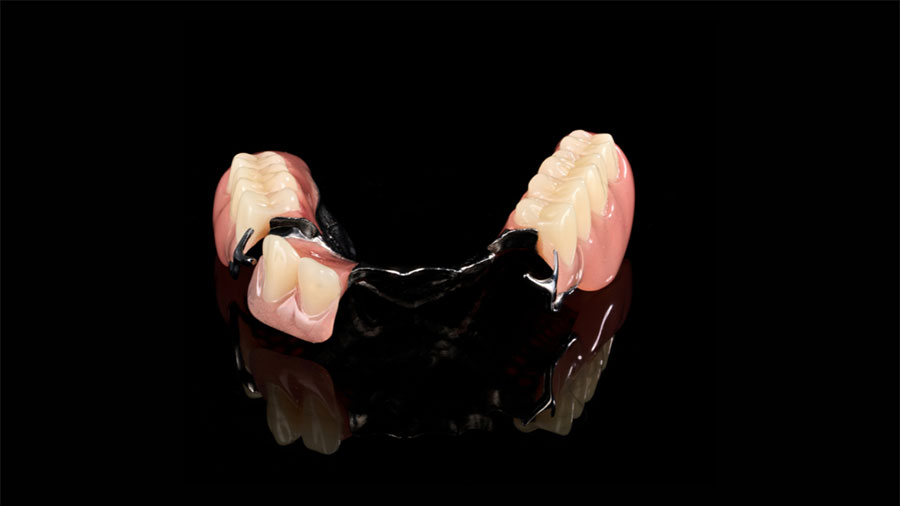Răng giả bán phần nhựa là phục hình tháo lắp, được thiết kế để thay thế răng mất. Chúng được làm từ nền nhựa acrylic chất lượng cao, nâng đỡ các răng giả, mang lại giải pháp chức năng và thẩm mỹ cho bệnh nhân cần lựa chọn thay thế răng tiết kiệm, tạm thời, hoặc lâu dài.

Mục lục [Hiển thị]
Răng giả bán phần nhựa là phục hình tháo lắp, được thiết kế để thay thế răng mất. Chúng được làm từ nền nhựa acrylic chất lượng cao, nâng đỡ các răng giả, mang lại giải pháp chức năng và thẩm mỹ cho bệnh nhân cần lựa chọn thay thế răng tiết kiệm, tạm thời, hoặc lâu dài. Bài viết này sẽ cung cấp thông tin toàn diện về răng giả bán phần nhựa.

Vật liệu sử dụng trong răng giả bán phần nhựa
Vật liệu chính là polymethyl methacrylate (PMMA), một loại nhựa acrylic bền chắc, đảm bảo sự thoải mái tối ưu. Răng giả thường được chế tạo từ nhựa acrylic, hoặc composite, để tạo vẻ tự nhiên. Ngoài ra, một số trường hợp còn gắn thêm móc kim loại, để tăng độ bám và ổn định.
Tìm hiểu thêm về vật liệu sản xuất răng giả tháo lắp: https://xdentlab.com/vi/nhung-vat-lieu-pho-bien-lam-rang-gia-thao-lap-trong-san-xuat-nha-khoa
Quy trình sản xuất răng giả bán phần nhựa

Bước 1: Nhận hồ sơ từ đối tác
Quy trình bắt đầu khi labo nhận hồ sơ từ nha sĩ, hoặc phòng khám. Bao gồm dấu hàm và yêu cầu thiết kế cụ thể.
Bước 2: Đổ mẫu
Dấu hàm được dùng để tạo mẫu thạch cao, hoặc nhựa, làm cơ sở chính xác cho việc chế tác răng giả.
Bước 3: Thiết kế răng giả bán phần
Kỹ thuật viên sử dụng kỹ thuật số, hoặc thủ công, để thiết kế răng giả. Đảm bảo vừa khít, chức năng và thẩm mỹ.
Bước 4: Sắp răng và thử sáp
Kỹ thuật viên sắp răng trên nền sáp, để mô phỏng hàm và khớp cắn tự nhiên của bệnh nhân, trước khi tiến hành các bước tiếp theo.
Bước 5: Đóng khuôn và loại bỏ sáp
Mô hình sáp được đặt vào khuôn, sau đó loại bỏ sáp, để tạo khuôn trống cho vật liệu acrylic.
Bước 6: Xử lý nhựa acrylic
Nhựa acrylic được bơm vào khuôn và xử lý bằng nhiệt, hoặc áp suất, để tạo thành hàm giả hoàn chỉnh.
Bước 7: Hoàn thiện và đánh bóng
Kỹ thuật viên cắt gọt, làm nhẵn và đánh bóng răng giả, để tăng sự thoải mái và thẩm mỹ.
Bước 8: Kiểm tra chất lượng cuối cùng
Sản phẩm được kiểm tra kỹ lưỡng, để đảm bảo đạt tiêu chuẩn chất lượng cao, trước khi gửi về phòng khám cho bệnh nhân thử và lắp.
Ưu điểm và nhược điểm của răng giả bán phần nhựa

Ưu điểm
Chi phí hợp lý: Răng giả nhựa thường rẻ hơn so với khung kim loại.
Dễ chỉnh sửa: Vật liệu nhựa cho phép dễ dàng chỉnh sửa, lót lại.
Thời gian chế tác nhanh: Phù hợp làm giải pháp tạm thời, hoặc thay thế trong thời gian chờ đợi răng giả kim loại.
Nhược điểm
Thiết kế dày, cồng kềnh: Nền nhựa cần dày, để đảm bảo độ bền, có thể gây cảm giác cộm trong miệng.
Có thể gây khó chịu: Độ dày nền nhựa có thể khiến việc ăn nhai, phát âm khó khăn trong thời gian đầu.
Tuổi thọ ngắn hơn: Răng giả nhựa thường cần thay mới sau khoảng 5 năm, do hao mòn và dễ gãy.
Nơi sản xuất răng giả bán phần nhựa chất lượng cao?

Tầm quan trọng của việc chọn đúng nhà sản xuất
Lựa chọn labo uy tín là yếu tố then chốt đảm bảo chất lượng, độ chính xác và sự hài lòng của bệnh nhân.
Vì sao các chuyên gia tin tưởng XDENT LAB
XDENT LAB chuyên sản xuất răng giả tháo lắp, đảm bảo chức năng, thẩm mỹ và sự thoải mái tối ưu cho bệnh nhân. Chúng tôi cung cấp cho các labo tại Mỹ:
Công nghệ hiện đại: Ứng dụng quy trình kỹ thuật số tiên tiến, đảm bảo độ chính xác.
Tay nghề cao: Đội ngũ kỹ thuật viên mang lại kết quả thẩm mỹ và chính xác.
Giá cạnh tranh: Giải pháp tiết kiệm, mà vẫn đảm bảo chất lượng.
Răng giả bán phần nhựa là lựa chọn thiết yếu cho bệnh nhân cần phục hình răng vừa chức năng, vừa tiết kiệm. Hiểu quy trình chế tác, ưu nhược điểm, sẽ giúp các nha sĩ và labo đưa ra quyết định phù hợp. Nếu bạn cần răng giả bán phần nhựa chất lượng cao, XDENT LAB là đối tác đáng tin cậy, cam kết chất lượng cho từng ca phục hình. Liên hệ với chúng tôi ngay hôm nay, để tìm hiểu thêm về dịch vụ labo răng giả của chúng tôi!
XDENT LAB là chuyên gia trong lĩnh vực Dịch vụ Lab-to-Lab tổng thể đến từ Việt Nam. Nổi bật với các dịch vụ phục hình tháo lắp và phục hình trên implant, đáp ứng tiêu chuẩn thị trường Hoa Kỳ – được FDA và ISO chứng nhận. Thành lập năm 2017, XDENT LAB đã phát triển từ quy mô địa phương vươn tầm quốc tế, hiện sở hữu 2 nhà máy và hơn 100 nhân viên. Công nghệ hiện đại, đội ngũ kỹ thuật viên được chứng nhận và cam kết tuân thủ quy định, giúp XDENT LAB trở thành lựa chọn tin cậy cho các phòng labo nha khoa mong muốn đảm bảo chất lượng và sự đồng nhất cho sản phẩm của mình.

Cam kết của chúng tôi:
- 100% vật liệu được FDA phê duyệt.
- Sản xuất quy mô lớn, năng suất cao, tỷ lệ làm lại < 1%.
- Thời gian hoàn thành trong labo 2~3 ngày (*áp dụng cho file kỹ thuật số).
- Tiết kiệm chi phí lên đến 30%.
- Sản xuất liên tục 365 ngày/năm, không gián đoạn.
Liên hệ với chúng tôi ngay hôm nay, để xây dựng chiến lược giảm chi phí vận hành.
--------❃--------
Labo Gia Công Nha Khoa Việt Nam - XDENT LAB
🏢 Nhà máy 1: 95/6 Đường Trần Văn Kiểu, Phường Bình Phú, TP. Hồ Chí Minh, Việt Nam
🏢 Nhà máy 2: Khu công nghiệp Kizuna 3, Xã Cần Giuộc, Tỉnh Tây Ninh, Việt Nam
☎ Hotline: 0919 796 718 📰 Nhận báo giá chi tiết
Chia sẻ bài viết này:






